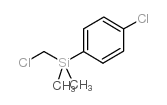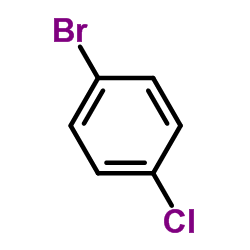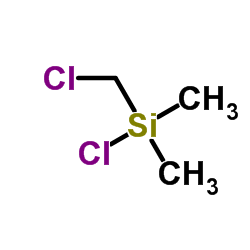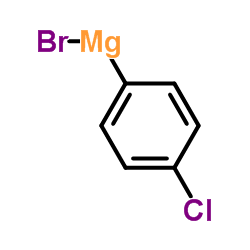chloromethyl(4-chlorophenyl)dimethylsilane
Modify Date: 2024-01-02 09:24:16

chloromethyl(4-chlorophenyl)dimethylsilane structure
|
Common Name | chloromethyl(4-chlorophenyl)dimethylsilane | ||
|---|---|---|---|---|
| CAS Number | 770-89-8 | Molecular Weight | 219.18300 | |
| Density | 1.1g/cm3 | Boiling Point | 87-89ºC (1 mmHg) | |
| Molecular Formula | C9H12Cl2Si | Melting Point | N/A | |
| MSDS | N/A | Flash Point | 116.1ºC | |
| Name | chloromethyl-(4-chlorophenyl)-dimethylsilane |
|---|---|
| Synonym | More Synonyms |
| Density | 1.1g/cm3 |
|---|---|
| Boiling Point | 87-89ºC (1 mmHg) |
| Molecular Formula | C9H12Cl2Si |
| Molecular Weight | 219.18300 |
| Flash Point | 116.1ºC |
| Exact Mass | 218.00900 |
| LogP | 3.45170 |
| Index of Refraction | 1.536-1.538 |
Synonym: Chloromethyl-(4-Chlorophenyl)Dimethylsilane SECTION 2 - COMPOSITION, INFORMATION ON INGREDIENTS
Hazard Symbols: C SECTION 3 - HAZARDS IDENTIFICATION EMERGENCY OVERVIEW Causes burns.Corrosive. Potential Health Effects Eye: Causes eye burns. Skin: Causes skin burns.
Ingestion: May cause severe and permanent damage to the digestive tract. Causes gastrointestinal tract burns. May cause nausea and vomiting. Inhalation: Causes chemical burns to the respiratory tract. Inhalation may be fatal as a result of spasm, inflammation, edema of the larynx and bronchi, chemical pneumonitis and pulmonary edema. Chronic: No information found. SECTION 4 - FIRST AID MEASURES Eyes: Get medical aid. Do NOT allow victim to rub eyes or keep eyes closed. Extensive irrigation with water is required (at least 30 minutes). Skin: Get medical aid. Flush skin with plenty of water for at least 15 minutes while removing contaminated clothing and shoes. Wash clothing before reuse. Destroy contaminated shoes. Ingestion: Never give anything by mouth to an unconscious person. Get medical aid. Do NOT induce vomiting. If conscious and alert, rinse mouth and drink 2-4 cupfuls of milk or water. Inhalation: Remove from exposure and move to fresh air immediately. Get medical aid. Do NOT use mouth-to-mouth resuscitation. If breathing has ceased apply artificial respiration using oxygen and a suitable mechanical device such as a bag and a mask. Notes to Physician: SECTION 5 - FIRE FIGHTING MEASURES General Information: As in any fire, wear a self-contained breathing apparatus in pressure-demand, MSHA/NIOSH (approved or equivalent), and full protective gear. During a fire, irritating and highly toxic gases may be generated by thermal decomposition or combustion. Use water spray to keep fire-exposed containers cool. Vapors may be heavier than air. They can spread along the ground and collect in low or confined areas. Containers may explode when heated. Extinguishing Media: Use agent most appropriate to extinguish fire. Cool containers with flooding quantities of water until well after fire is out. Use water spray, dry chemical, carbon dioxide, or appropriate foam. SECTION 6 - ACCIDENTAL RELEASE MEASURES General Information: Use proper personal protective equipment as indicated in Section 8. Spills/Leaks: Absorb spill with inert material (e.g. vermiculite, sand or earth), then place in suitable container. Avoid runoff into storm sewers and ditches which lead to waterways. Clean up spills immediately, observing precautions in the Protective Equipment section. Provide ventilation. SECTION 7 - HANDLING and STORAGE Handling: Wash thoroughly after handling. Use with adequate ventilation. Avoid contact with eyes, skin, and clothing. Keep container tightly closed. Avoid ingestion and inhalation. Do not ingest or inhale. Use only in a chemical fume hood. Discard contaminated shoes. Storage: Keep container closed when not in use. Keep under a nitrogen blanket. Store in a cool, dry, well-ventilated area away from incompatible substances. Corrosives area. SECTION 8 - EXPOSURE CONTROLS, PERSONAL PROTECTION Engineering Controls: Facilities storing or utilizing this material should be equipped with an eyewash facility and a safety shower. Use adequate ventilation to keep airborne concentrations low. Exposure Limits CAS# 770-89-8: Personal Protective Equipment Eyes: Wear appropriate protective eyeglasses or chemical safety goggles as described by OSHA's eye and face protection regulations in 29 CFR 1910.133 or European Standard EN166. Skin: Wear appropriate protective gloves to prevent skin exposure. Clothing: Wear appropriate protective clothing to prevent skin exposure. Respirators: A respiratory protection program that meets OSHA's 29 CFR 1910.134 and ANSI Z88.2 requirements or European Standard EN 149 must be followed whenever workplace conditions warrant respirator use. SECTION 9 - PHYSICAL AND CHEMICAL PROPERTIES Physical State: Liquid Color: clear almost colorless Odor: Not available. pH: Not available. Vapor Pressure: Not available. Viscosity: Not available. Boiling Point: 119 - 120 deg C @ 3.00mm Hg Freezing/Melting Point: Not available. Autoignition Temperature: Not available. Flash Point: Not available. Explosion Limits, lower: Not available. Explosion Limits, upper: Not available. Decomposition Temperature: Solubility in water: Specific Gravity/Density: Molecular Formula: C9H12Cl2Si Molecular Weight: 219.19 SECTION 10 - STABILITY AND REACTIVITY Chemical Stability: Stable at room temperature in closed containers under normal storage and handling conditions. Conditions to Avoid: Incompatible materials, excess heat, oxidizers. Incompatibilities with Other Materials: Oxidizing agents. Hazardous Decomposition Products: Hydrogen chloride, carbon monoxide, irritating and toxic fumes and gases, carbon dioxide, silicon dioxide. Hazardous Polymerization: Has not been reported. SECTION 11 - TOXICOLOGICAL INFORMATION RTECS#: CAS# 770-89-8 unlisted. LD50/LC50: Not available. Carcinogenicity: Chloromethyl Dimethyl-4-Chlorophenylsilane - Not listed by ACGIH, IARC, or NTP. SECTION 12 - ECOLOGICAL INFORMATION SECTION 13 - DISPOSAL CONSIDERATIONS Dispose of in a manner consistent with federal, state, and local regulations. SECTION 14 - TRANSPORT INFORMATION IATA Shipping Name: CORROSIVE LIQUID, N.O.S. Hazard Class: 8 UN Number: 1760 Packing Group: III IMO Shipping Name: CORROSIVE LIQUID, N.O.S. Hazard Class: 8 UN Number: 1760 Packing Group: III RID/ADR Shipping Name: CORROSIVE LIQUID, N.O.S. Hazard Class: 8 UN Number: 1760 Packing group: III SECTION 15 - REGULATORY INFORMATION European/International Regulations European Labeling in Accordance with EC Directives Hazard Symbols: C Risk Phrases: R 34 Causes burns. Safety Phrases: S 25 Avoid contact with eyes. S 28A After contact with skin, wash immediately with plenty of water. S 36/37/39 Wear suitable protective clothing, gloves and eye/face protection. S 37 Wear suitable gloves. S 45 In case of accident or if you feel unwell, seek medical advice immediately (show the label where possible). WGK (Water Danger/Protection) CAS# 770-89-8: No information available. Canada None of the chemicals in this product are listed on the DSL/NDSL list. CAS# 770-89-8 is not listed on Canada's Ingredient Disclosure List. US FEDERAL TSCA CAS# 770-89-8 is not listed on the TSCA inventory. It is for research and development use only. SECTION 16 - ADDITIONAL INFORMATION MSDS Creation Date: 2/19/1999 Revision #2 Date: 3/18/2003 The information above is believed to be accurate and represents the best information currently available to us. However, we make no warranty of merchantability or any other warranty, express or implied, with respect to such information, and we assume no liability resulting from its use. Users should make their own investigations to determine the suitability of the information for their particular purposes. In no way shall the company be liable for any claims, losses, or damages of any third party or for lost profits or any special, indirect, incidental, consequential or exemplary damages, howsoever arising, even if the company has been advised of the possibility of such damages. SECTION 16 - ADDITIONAL INFORMATION N/A |
|
~53% 
chloromethyl(4-... CAS#:770-89-8 |
| Literature: E. I. Du Pont de Nemours and Company Patent: US4496551 A1, 1985 ; |
|
~55% 
chloromethyl(4-... CAS#:770-89-8 |
| Literature: E. I. Du Pont de Nemours and Company Patent: US4510136 A1, 1985 ; |
|
~% 
chloromethyl(4-... CAS#:770-89-8 |
| Literature: Bulletin of the Academy of Sciences of the USSR, Division of Chemical Science (English Translation), , p. 1858 - 1862 Izvestiya Akademii Nauk SSSR, Seriya Khimicheskaya, , p. 1951 - 1956 |
|
~% 
chloromethyl(4-... CAS#:770-89-8 |
| Literature: Journal of the Chemical Society, , p. 4266 Huaxue Xuebao, , vol. 25, p. 330,331-340 Chem.Abstr., , # 16375 |
| chloromethyl dimethyl-4-chlorophenylsilane |
| MFCD00800543 |




 CAS#:62244-51-3
CAS#:62244-51-3